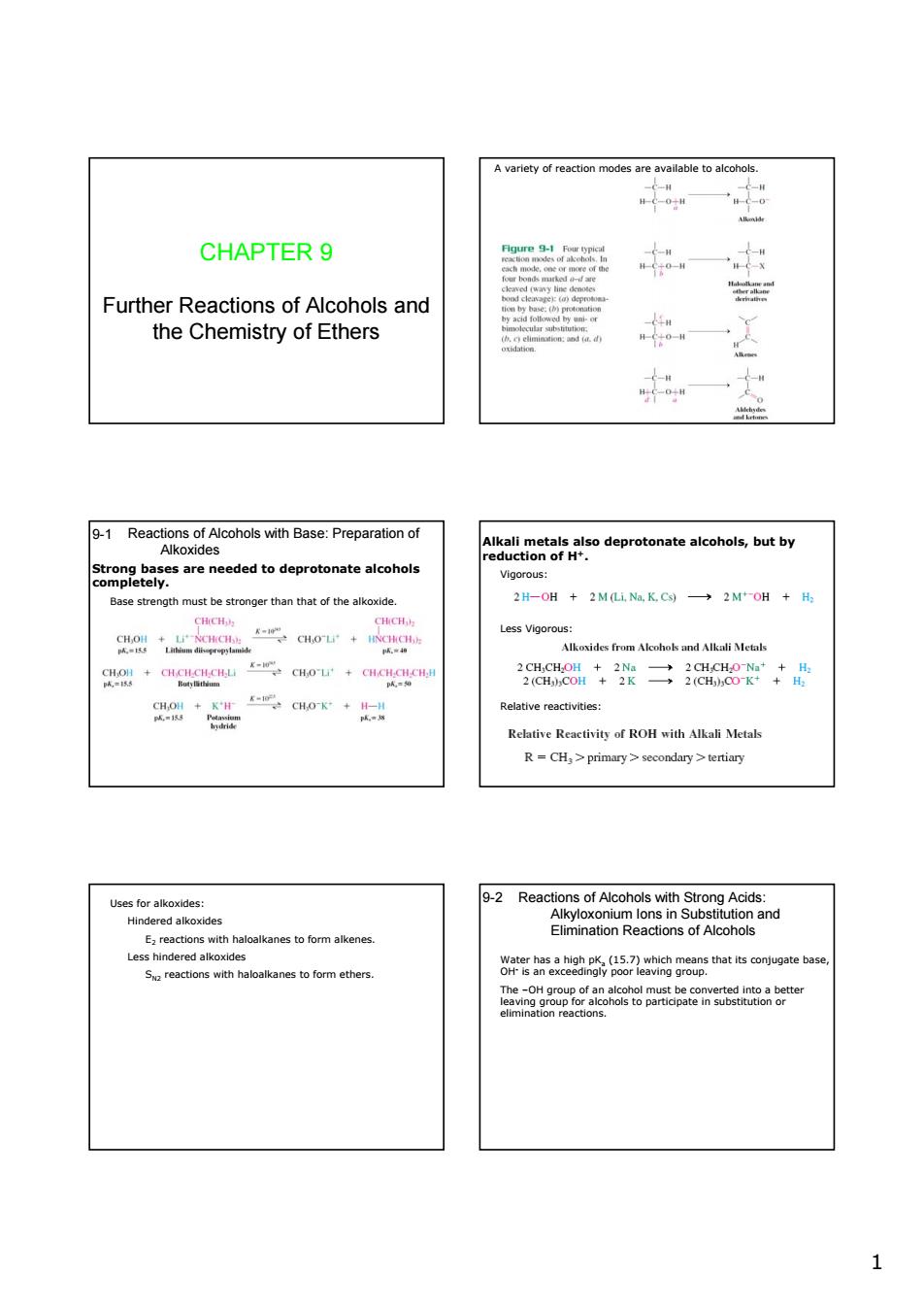
A variety of reaction modes are ble to alcoho CHAPTER 9 一 Further Reactions of Alcohols and the Chemistry of Ethers 一 一大 -1 Reactions of Alcohols with Base:Preparation of edtodeprotonate ealoetetsodeprotonatealcoholsbutby 2H-OH 2M(Li,Na.K.C)+H tfatrtund auliitk 20+次二 Relative Reactivity of ROH with Alkali Mctals R-CH,primary secondary tertiary -2 Reactions of Acohols nesto form aenes. S reactions with haloalkanes to form ethers that tcon 82e88nea 1
1 CHAPTER 9 Further Reactions of Alcohols and the Chemistry of Ethers A variety of reaction modes are available to alcohols. Reactions of Alcohols with Base: Preparation of Alkoxides 9-1 Strong bases are needed to deprotonate alcohols completely. Base strength must be stronger than that of the alkoxide. Alkali metals also deprotonate alcohols, but by reduction of H+. Vigorous: Less Vigorous: Relative reactivities: Uses for alkoxides: Hindered alkoxides E2 reactions with haloalkanes to form alkenes. Less hindered alkoxides SN2 reactions with haloalkanes to form ethers. Reactions of Alcohols with Strong Acids: Alkyloxonium Ions in Substitution and Elimination Reactions of Alcohols 9-2 Water has a high pKa (15.7) which means that its conjugate base, OH- is an exceedingly poor leaving group. The –OH group of an alcohol must be converted into a better leaving group for alcohols to participate in substitution or elimination reactions
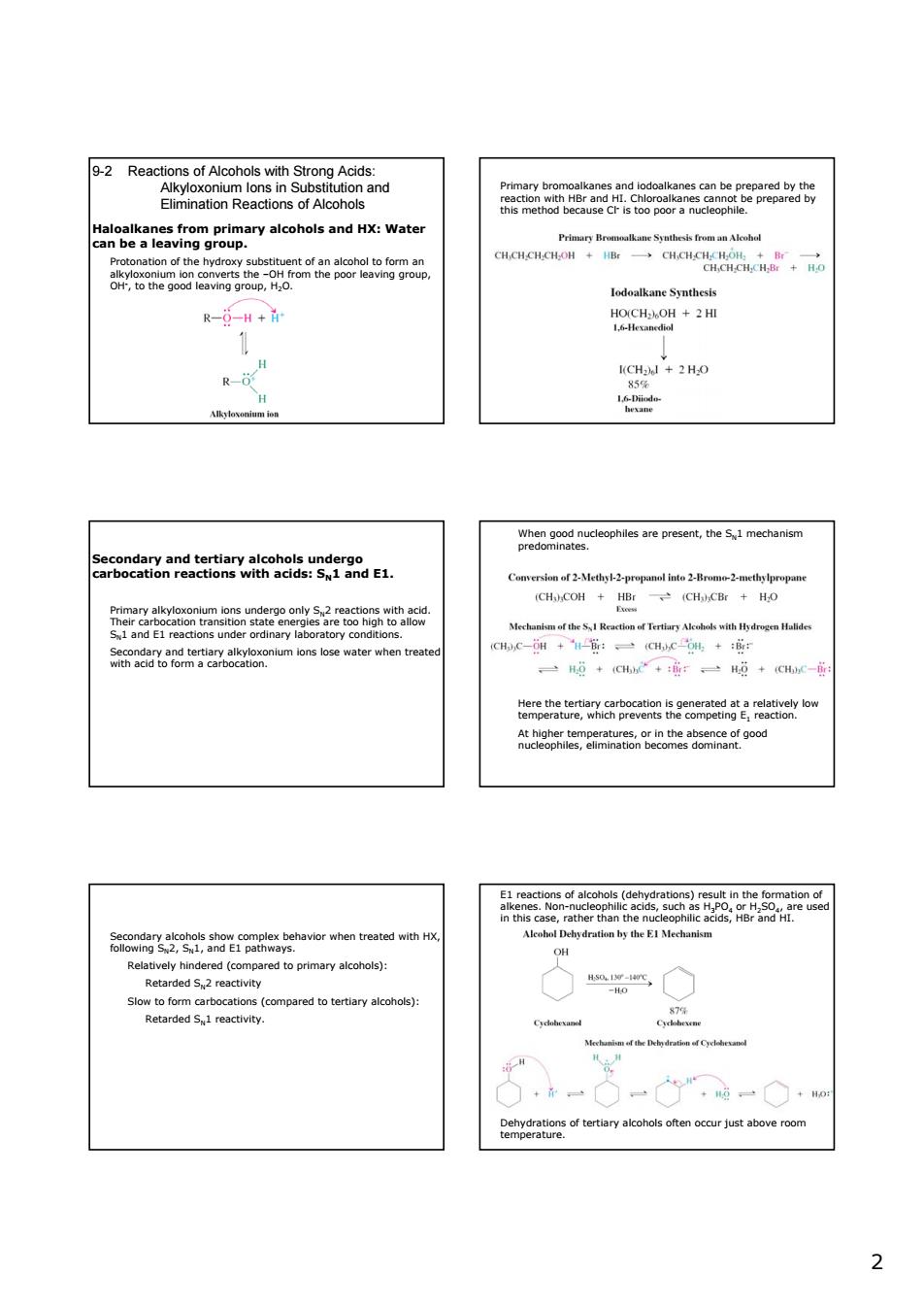
9-2 Reactions of Alcohols with Strong Acids: ahieaiRecionesctAooeand e2 oo poor a lodealkane Synthesis R-5-H+ R-0 uhiesre presen,themechanism of 2-Mety2-propaml tc8Yo6geentnlomsbewaterwh。 、6+4aM2◆面:、H0+GHC-武 emeeeaeenmCarteaoeseoemeeagtereseneo OH slowtofomcarbcl mpared to tertiary alcohols): Retarded ehgiesoftathryalkohesotemcaurjustabovweoem 2
2 Reactions of Alcohols with Strong Acids: Alkyloxonium Ions in Substitution and Elimination Reactions of Alcohols 9-2 Haloalkanes from primary alcohols and HX: Water can be a leaving group. Protonation of the hydroxy substituent of an alcohol to form an alkyloxonium ion converts the –OH from the poor leaving group, OH- , to the good leaving group, H2O. Primary bromoalkanes and iodoalkanes can be prepared by the reaction with HBr and HI. Chloroalkanes cannot be prepared by this method because Cl- is too poor a nucleophile. Secondary and tertiary alcohols undergo carbocation reactions with acids: SN1 and E1. Primary alkyloxonium ions undergo only SN2 reactions with acid. Their carbocation transition state energies are too high to allow SN1 and E1 reactions under ordinary laboratory conditions. Secondary and tertiary alkyloxonium ions lose water when treated with acid to form a carbocation. When good nucleophiles are present, the SN1 mechanism predominates. Here the tertiary carbocation is generated at a relatively low temperature, which prevents the competing E1 reaction. At higher temperatures, or in the absence of good nucleophiles, elimination becomes dominant. Secondary alcohols show complex behavior when treated with HX, following SN2, SN1, and E1 pathways. Relatively hindered (compared to primary alcohols): Retarded SN2 reactivity Slow to form carbocations (compared to tertiary alcohols): Retarded SN1 reactivity. E1 reactions of alcohols (dehydrations) result in the formation of alkenes. Non-nucleophilic acids, such as H3PO4 or H2SO4, are used in this case, rather than the nucleophilic acids, HBr and HI. Dehydrations of tertiary alcohols often occur just above room temperature
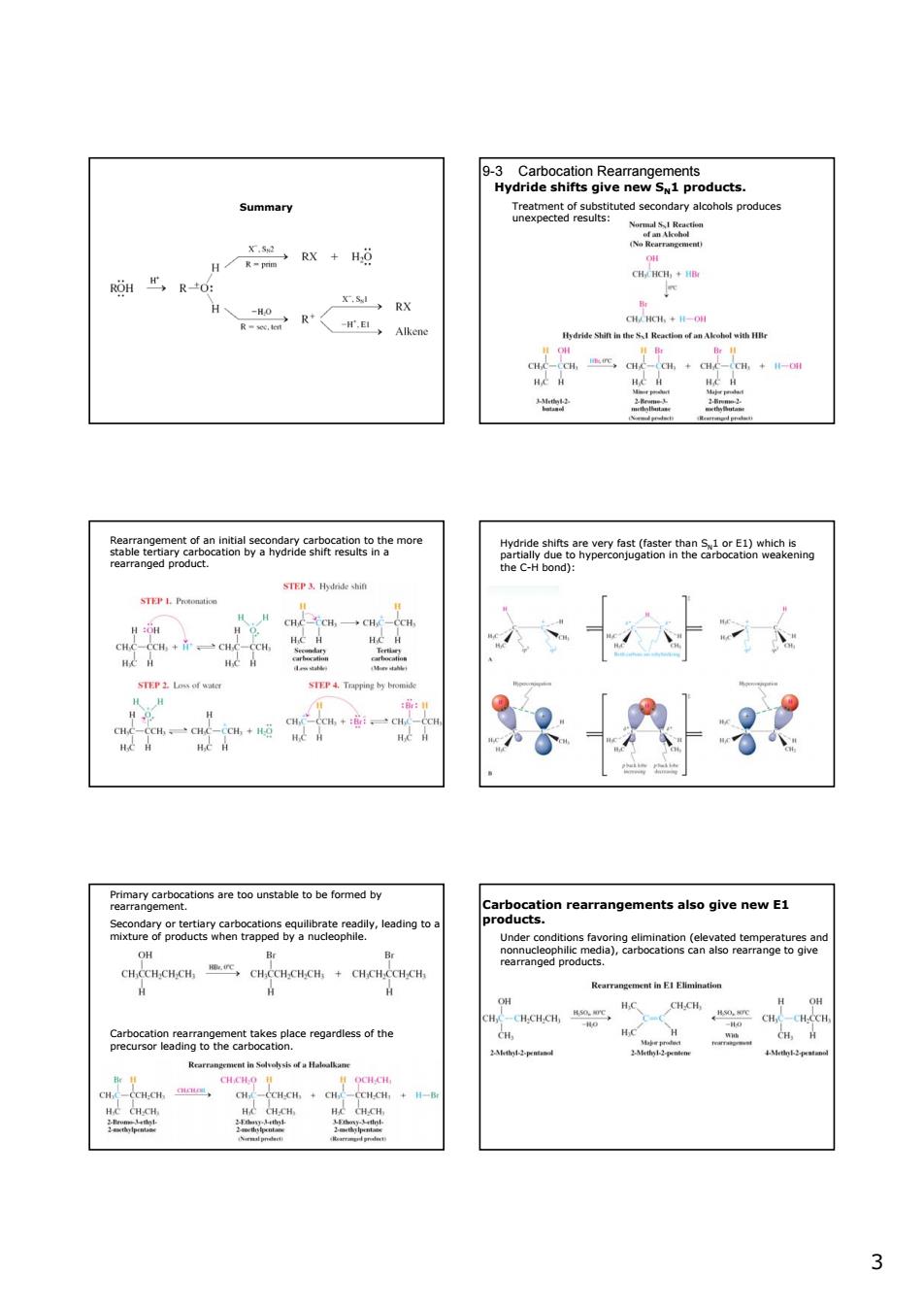
Summary .RX w2a sE 88 rearranger ents also give new E1 arran ataeagR022ahcewardsve .2-pu 3
3 Summary 9-3 Carbocation Rearrangements Hydride shifts give new SN1 products. Treatment of substituted secondary alcohols produces unexpected results: Rearrangement of an initial secondary carbocation to the more stable tertiary carbocation by a hydride shift results in a rearranged product. Hydride shifts are very fast (faster than SN1 or E1) which is partially due to hyperconjugation in the carbocation weakening the C-H bond): Primary carbocations are too unstable to be formed by rearrangement. Secondary or tertiary carbocations equilibrate readily, leading to a mixture of products when trapped by a nucleophile. Carbocation rearrangement takes place regardless of the precursor leading to the carbocation. Carbocation rearrangements also give new E1 products. Under conditions favoring elimination (elevated temperatures and nonnucleophilic media), carbocations can also rearrange to give rearranged products
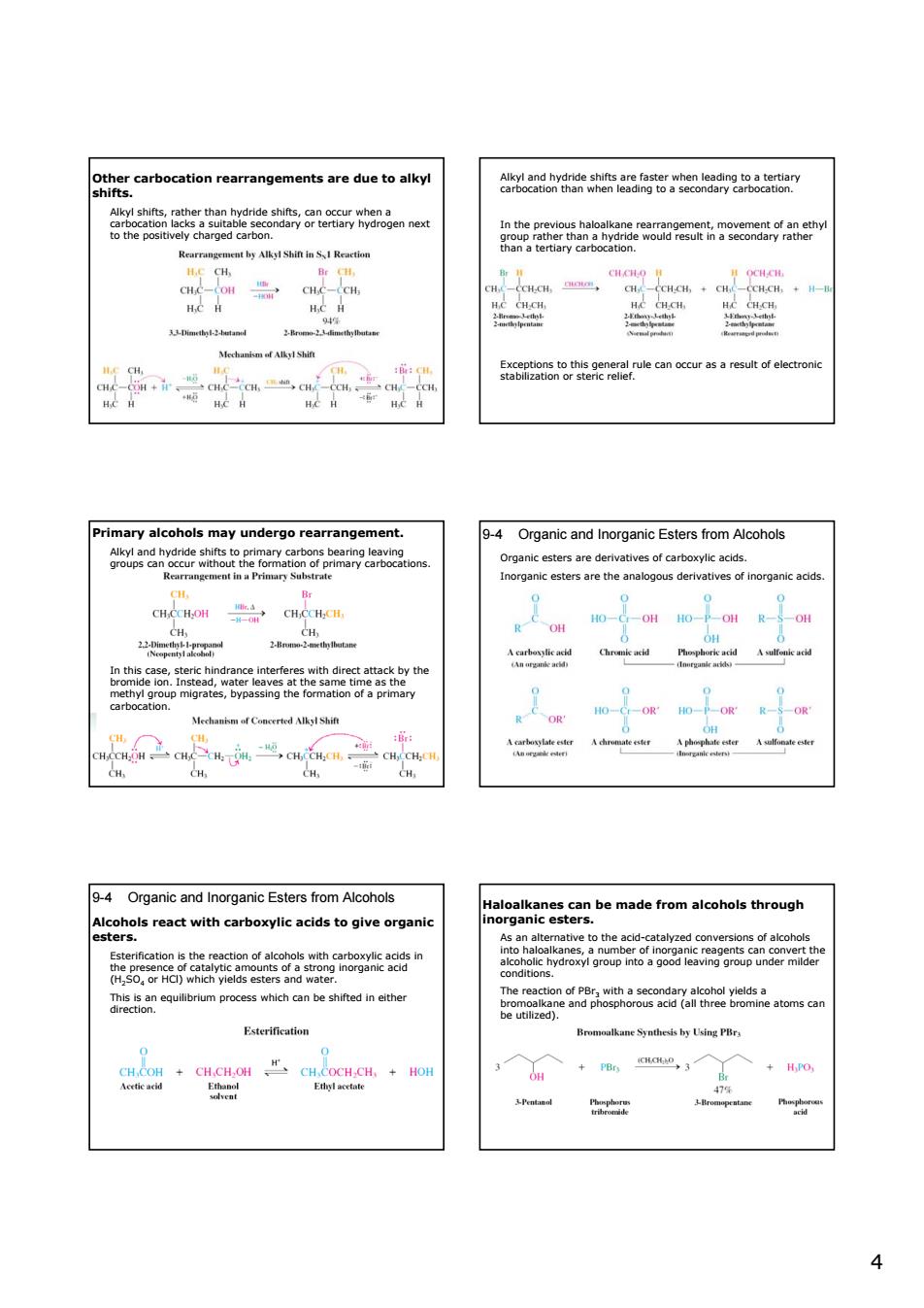
gmare due toalky aaoaatees8esaeeeyean8oaY :dgb-ledend Primary alcohols may undergo rearrangement. 9-4 Organic and Inorganic Esters from Alcohols Organic esters are derivatives of carboxylic acids. Inorganic esters are the analogous derivatives of inorga Mehankm af Ceeedl shin 1...1 9-4 Organic and Inorganic Esters from Alcohols Aicohols react with carboxylic acids to give organic 4
4 Other carbocation rearrangements are due to alkyl shifts. Alkyl shifts, rather than hydride shifts, can occur when a carbocation lacks a suitable secondary or tertiary hydrogen next to the positively charged carbon. Alkyl and hydride shifts are faster when leading to a tertiary carbocation than when leading to a secondary carbocation. In the previous haloalkane rearrangement, movement of an ethyl group rather than a hydride would result in a secondary rather than a tertiary carbocation. Exceptions to this general rule can occur as a result of electronic stabilization or steric relief. Primary alcohols may undergo rearrangement. Alkyl and hydride shifts to primary carbons bearing leaving groups can occur without the formation of primary carbocations. In this case, steric hindrance interferes with direct attack by the bromide ion. Instead, water leaves at the same time as the methyl group migrates, bypassing the formation of a primary carbocation. 9-4 Organic and Inorganic Esters from Alcohols Organic esters are derivatives of carboxylic acids. Inorganic esters are the analogous derivatives of inorganic acids. 9-4 Organic and Inorganic Esters from Alcohols Alcohols react with carboxylic acids to give organic esters. Esterification is the reaction of alcohols with carboxylic acids in the presence of catalytic amounts of a strong inorganic acid (H2SO4 or HCl) which yields esters and water. This is an equilibrium process which can be shifted in either direction. Haloalkanes can be made from alcohols through inorganic esters. As an alternative to the acid-catalyzed conversions of alcohols into haloalkanes, a number of inorganic reagents can convert the alcoholic hydroxyl group into a good leaving group under milder conditions. The reaction of PBr3 with a secondary alcohol yields a bromoalkane and phosphorous acid (all three bromine atoms can be utilized)
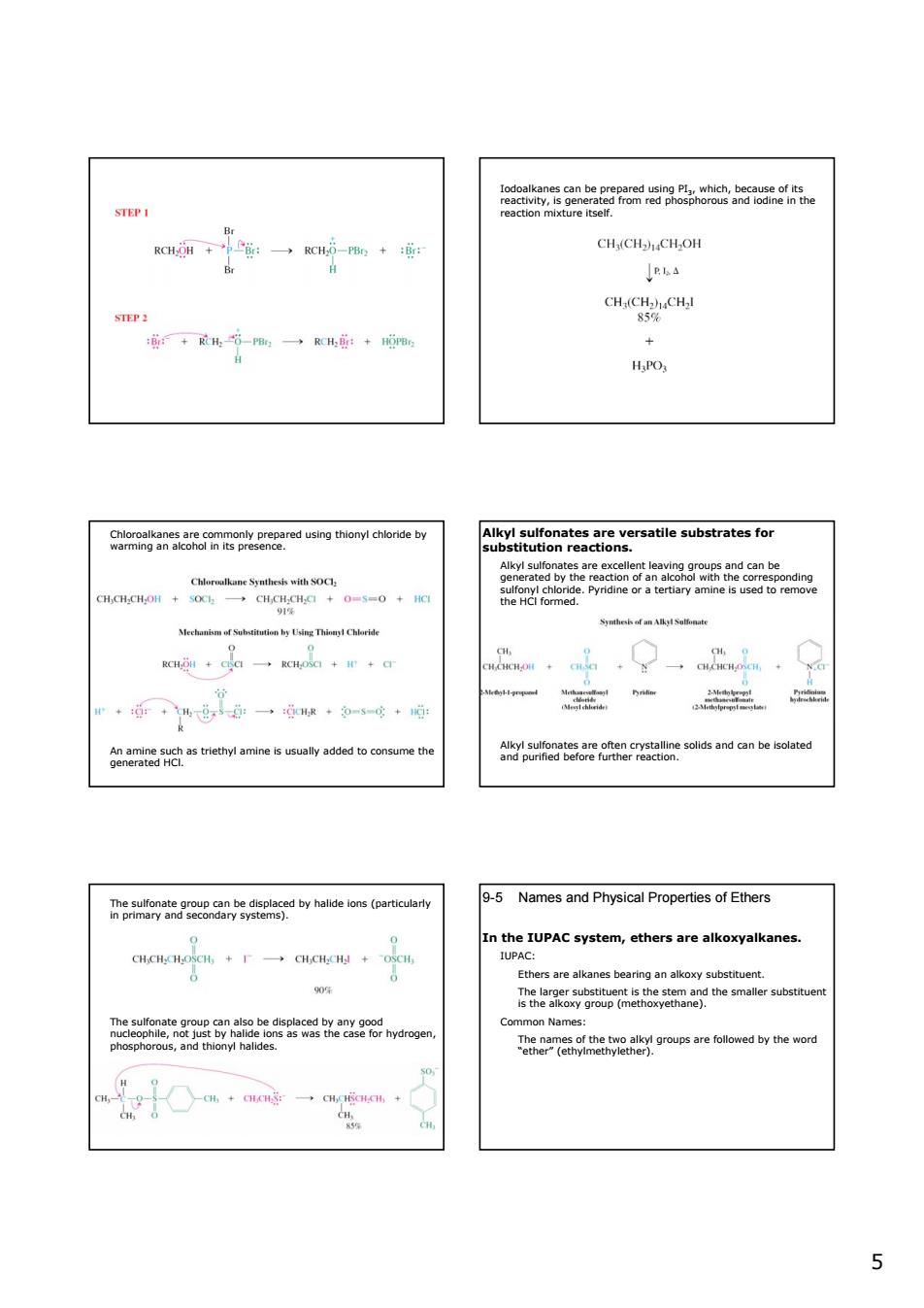
STEPI CH/CH2.CH.OH : ouU HPOs Ceogans8sBagrcausngthomndhenae7 substrates for haan与nI Cre +道r4,0一0·多-g+心 的,d 9-5 Names and Physical Properties of Ethers in the IUPAC system,ethers are alkoxyalkanes m 5
5 Iodoalkanes can be prepared using PI3, which, because of its reactivity, is generated from red phosphorous and iodine in the reaction mixture itself. Chloroalkanes are commonly prepared using thionyl chloride by warming an alcohol in its presence. An amine such as triethyl amine is usually added to consume the generated HCl. Alkyl sulfonates are versatile substrates for substitution reactions. Alkyl sulfonates are excellent leaving groups and can be generated by the reaction of an alcohol with the corresponding sulfonyl chloride. Pyridine or a tertiary amine is used to remove the HCl formed. Alkyl sulfonates are often crystalline solids and can be isolated and purified before further reaction. The sulfonate group can be displaced by halide ions (particularly in primary and secondary systems). The sulfonate group can also be displaced by any good nucleophile, not just by halide ions as was the case for hydrogen, phosphorous, and thionyl halides. 9-5 Names and Physical Properties of Ethers In the IUPAC system, ethers are alkoxyalkanes. IUPAC: Ethers are alkanes bearing an alkoxy substituent. The larger substituent is the stem and the smaller substituent is the alkoxy group (methoxyethane). Common Names: The names of the two alkyl groups are followed by the word “ether” (ethylmethylether)